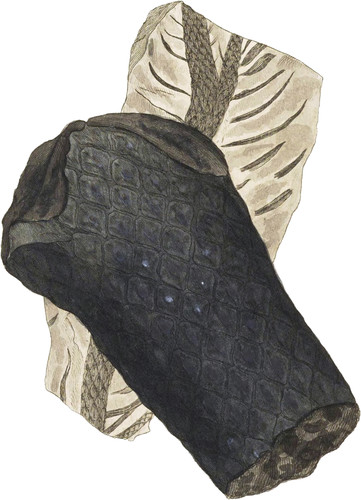 Enlarge
Enlarge
British Mineralogy
Plant-formed Coal
- Div. 2. Imitative.
No subject in Mineralogy is more deserving of the attention of mankind, or is perhaps more instructive, than the formation of Coals; whether it bespeaks the contrivance of a flood as necessary for their formation, or proves that they are in the great bulk, at least as far as we are allowed to penetrate, dependent on principles passing through organization. Nor is it the less curious, that while we have appeared so long ignorant as to the nature of the subject thus returning to an inorganized state, yet every day some fresh assistance meets our inquiries, as we are allowed to improve them by an industrious research. The present specimens are proofs of the eminent beauties constantly observable in the variations of Nature; and while they show an analogy to our modern system, yet present us with Genera and Species so foreign, that we are at a loss for comparison. The front specimen is the cast of a stem of some plant which is covered with a very regular arrangement of squamæ, such as remain occasionally after the old leaves are fallen off as the smaller branches advance. The squamæ are very perfect in appearance, and are arranged in spiral order; in some specimens the spire winds to the right, and in others to the left: those on the right hand side of the specimen figured have an embossed centre, and an apex somewhat thickened, and approaching the obtuse! triangular scar that the leaves of many plants leave after falling off, with the decurrent swelling below, The nearest approach to this regular lozenge formation is in the small branches of some species of pines, Euphorbias or Proteæ. From the larger flatted impressions and the smaller branched ones, it should appear that this was not a very small species of plant. I have a flattened impression that is seven inches wide, and this specimen is smaller than some others which I have, but was chosen for its having the divided end, showing that the plant branched, besides the sign of the two pith-like round holes, one for each branch, remarkable for being on one side in these, as well as in those not branching. The hollow is generally longitudinally striated.
The other specimen shows a smaller branch, with some remains of leaves which are a little carinated, acute, in length about twelve or sixteen times their breadth, and swelling a little from their base.
These specimens are both Ironstone, upon which the coaly remains of the plants are impressed. In the front specimen, the Coal has the usual fracture, and is about the tenth of an inch thick where the squamæ are most distinct, as one side has only little regular embossments, the squamæ being obliterated by scaling off or wearing; or perhaps they were never so perfectly formed, on account of their being in a position less fitted to preserve them: this ought to be noticed, lest in some instances it should lead to mistake in the species.
Other species of similar construction are found at Lord Middlemen’s, Woollarton, near Nottingham, I have, among other remarkable ones, some much branched, by favour of Thomas Meade, Esq., from Poulton in Somersetshire.

